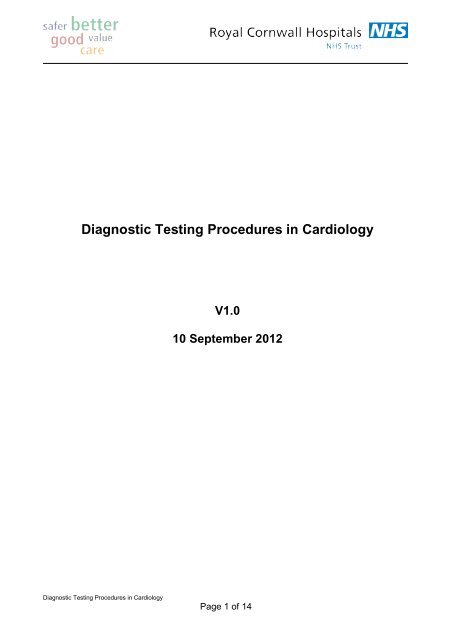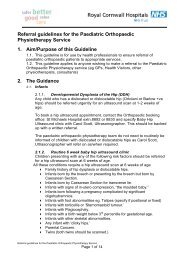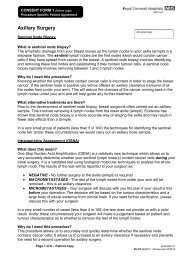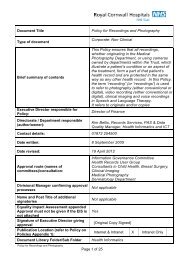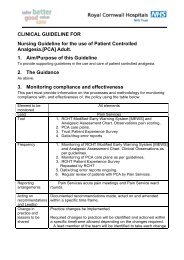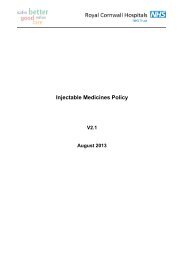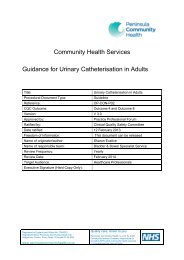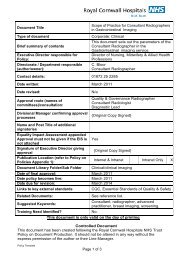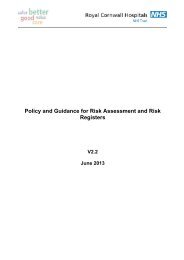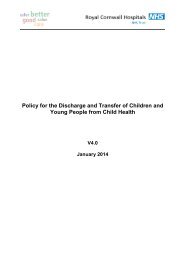Diagnostic Testing Procedures in Cardiology - the Royal Cornwall ...
Diagnostic Testing Procedures in Cardiology - the Royal Cornwall ...
Diagnostic Testing Procedures in Cardiology - the Royal Cornwall ...
You also want an ePaper? Increase the reach of your titles
YUMPU automatically turns print PDFs into web optimized ePapers that Google loves.
<strong>Diagnostic</strong> <strong>Test<strong>in</strong>g</strong> <strong>Procedures</strong> <strong>in</strong> <strong>Cardiology</strong><br />
V1.0<br />
10 September 2012<br />
<strong>Diagnostic</strong> <strong>Test<strong>in</strong>g</strong> <strong>Procedures</strong> <strong>in</strong> <strong>Cardiology</strong><br />
Page 1 of 14
Table of Contents<br />
1. Introduction ................................................................................................................... 3<br />
2. Purpose of this Policy/Procedure .................................................................................. 3<br />
3. Scope ........................................................................................................................... 3<br />
4. Def<strong>in</strong>itions / Glossary .................................................................................................... 3<br />
5. Ownership and Responsibilities .................................................................................... 3<br />
5.2. Role of <strong>the</strong> Managers ............................................................................................ 3<br />
5.3. Role of <strong>the</strong> Medic<strong>in</strong>e & ED Divisional Governance Management Board ............... 4<br />
5.5. Role of Individual Staff ........................................................................................... 4<br />
5.11. Role of Governance Leads ................................................................................ 4<br />
6. Standards and Practice ................................................................................................ 4<br />
6.1. <strong>Diagnostic</strong> tests provided by <strong>the</strong> service ............................................................... 4<br />
6.3. Risk assessment of diagnostic tests ...................................................................... 4<br />
6.7. Request<strong>in</strong>g diagnostic tests ................................................................................... 5<br />
6.9. Patient preparation ................................................................................................ 5<br />
6.11. Informed consent ............................................................................................... 5<br />
6.16. How <strong>the</strong> diagnostic test is requested ................................................................. 5<br />
6.24. How <strong>the</strong> person request<strong>in</strong>g <strong>the</strong> test is <strong>in</strong>formed of test results ........................... 6<br />
6.29. How <strong>the</strong> patient is <strong>in</strong>formed of test results ......................................................... 6<br />
6.33. Actions to be taken by a person receiv<strong>in</strong>g test results ....................................... 7<br />
6.39. How <strong>the</strong> m<strong>in</strong>imum requirements are recorded ................................................... 7<br />
6.54. How <strong>the</strong> organisation monitors compliance........................................................ 8<br />
7. Dissem<strong>in</strong>ation and Implementation ............................................................................... 8<br />
8. Monitor<strong>in</strong>g compliance and effectiveness ..................................................................... 8<br />
9. Updat<strong>in</strong>g and Review .................................................................................................... 9<br />
10. Equality and Diversity ................................................................................................ 9<br />
10.2. Equality Impact Assessment .............................................................................. 9<br />
Appendix 1. <strong>Diagnostic</strong> tests undertaken by <strong>the</strong> <strong>Cardiology</strong> Department ......................... 10<br />
Appendix 2. Governance Information ................................................................................ 11<br />
Appendix 3.Initial Equality Impact Assessment Screen<strong>in</strong>g Form ....................................... 13<br />
<strong>Diagnostic</strong> <strong>Test<strong>in</strong>g</strong> <strong>Procedures</strong> <strong>in</strong> <strong>Cardiology</strong><br />
Page 2 of 14
1. Introduction<br />
1.1. This policy describes <strong>the</strong> test<strong>in</strong>g procedures undertaken by <strong>the</strong> Department of<br />
<strong>Cardiology</strong> and sets out <strong>the</strong> procedures govern<strong>in</strong>g <strong>the</strong>ir procurement, performance<br />
and report<strong>in</strong>g.<br />
1.2. This version supersedes any previous versions of this document.<br />
2. Purpose of this Policy/Procedure<br />
2.1. The purpose of this policy is to prevent avoidable harm to patients who need<br />
cardiology tests, aris<strong>in</strong>g:<br />
2.1.1. directly from <strong>the</strong> tests performed, or<br />
2.1.2. from delays <strong>in</strong> tests be<strong>in</strong>g undertaken, or<br />
2.1.3. from delays <strong>in</strong> report<strong>in</strong>g <strong>the</strong> results of tests, or<br />
2.1.4. from delays <strong>in</strong> act<strong>in</strong>g upon <strong>the</strong> results.<br />
3. Scope<br />
3.1. This policy applies to all those who request cardiology diagnostic tests, those<br />
who perform <strong>the</strong>m and those who receive, process or need to act on <strong>the</strong> results.<br />
4. Def<strong>in</strong>itions / Glossary<br />
GP: General Practitioner<br />
CVIS: Cardiovascular Imag<strong>in</strong>g and Information System<br />
PAS: Patient Adm<strong>in</strong>istration System<br />
RCHT: <strong>Royal</strong> <strong>Cornwall</strong> Hospitals NHS Trust<br />
5. Ownership and Responsibilities<br />
5.1. The strategic and operational roles responsible for <strong>the</strong> development,<br />
management and implementation of <strong>the</strong> policy are shown below.<br />
5.2. Role of <strong>the</strong> Managers<br />
L<strong>in</strong>e managers are responsible for:<br />
• conduct<strong>in</strong>g str<strong>in</strong>gent recruitment checks to ensure that only appropriately<br />
qualified and registered staff undertake tests and authorise test results;<br />
• check<strong>in</strong>g professional registration <strong>in</strong> l<strong>in</strong>e with renewal requirements;<br />
• check<strong>in</strong>g staff tra<strong>in</strong><strong>in</strong>g and competence to perform tests;<br />
• ensur<strong>in</strong>g that staff follow established processes and procedures, as described<br />
below.<br />
<strong>Diagnostic</strong> <strong>Test<strong>in</strong>g</strong> <strong>Procedures</strong> <strong>in</strong> <strong>Cardiology</strong><br />
Page 3 of 14
5.3. Role of <strong>the</strong> Medic<strong>in</strong>e & ED Divisional Governance Management<br />
Board<br />
5.4. The Medic<strong>in</strong>e & ED Divisional Governance Management Board is responsible<br />
for <strong>the</strong> development, approval and communication of this policy and monitor<strong>in</strong>g<br />
compliance with it.<br />
5.5. Role of Individual Staff<br />
5.6. The diagnostic pathway beg<strong>in</strong>s when a request is generated; it progresses via<br />
<strong>the</strong> diagnostic test<strong>in</strong>g process and ends when a report is received by <strong>the</strong> requestor<br />
and acted upon. Various healthcare staff are <strong>in</strong>volved <strong>in</strong> this pathway <strong>in</strong>clud<strong>in</strong>g<br />
Doctors, Nurses, Healthcare Assistants/Support workers and Professions Allied to<br />
Medic<strong>in</strong>e.<br />
5.7. Ward based adm<strong>in</strong>istrative staff have an important role <strong>in</strong> ensur<strong>in</strong>g that, for<br />
paper based report<strong>in</strong>g systems, all results are communicated to <strong>the</strong> cl<strong>in</strong>ical staff <strong>in</strong><br />
charge of <strong>the</strong> patient.<br />
5.8. Adm<strong>in</strong>istrative staff <strong>in</strong> <strong>the</strong> Outpatient Book<strong>in</strong>g Office also have a role to play <strong>in</strong><br />
ensur<strong>in</strong>g diagnostic appo<strong>in</strong>tments are booked and appropriate preparation <strong>in</strong>stigated<br />
<strong>in</strong> accordance with agreed operat<strong>in</strong>g policies.<br />
5.9. <strong>Cardiology</strong> Department staff must ensure that any paper reports are<br />
despatched <strong>in</strong> a timely manner.<br />
5.10. All staff members are responsible for:<br />
• be<strong>in</strong>g aware of this policy and any documents referred to with<strong>in</strong> it perta<strong>in</strong><strong>in</strong>g to<br />
<strong>the</strong>ir part <strong>in</strong> <strong>the</strong> diagnostic pathway.<br />
• adher<strong>in</strong>g to any requirements described with<strong>in</strong> this policy and documents<br />
described <strong>in</strong> <strong>the</strong> standards and practice section perta<strong>in</strong><strong>in</strong>g to <strong>the</strong>ir role <strong>in</strong> <strong>the</strong><br />
diagnostic pathway.<br />
5.11. Role of Governance Leads<br />
5.12. It is <strong>the</strong> responsibility of Governance Leads to ensure that processes are <strong>in</strong><br />
place with<strong>in</strong> specialties which ensure that every cardiology test result is acted upon.<br />
6. Standards and Practice<br />
6.1. <strong>Diagnostic</strong> tests provided by <strong>the</strong> service<br />
6.2. A list of tests provided by <strong>the</strong> <strong>Cardiology</strong> Service may be found at Appendix 1.<br />
6.3. Risk assessment of diagnostic tests<br />
6.4. <strong>Diagnostic</strong> tests are evaluated prior to <strong>in</strong>troduction (e.g. to check that <strong>the</strong>y are<br />
‘fit for purpose’, that <strong>the</strong>y are with<strong>in</strong> <strong>the</strong> competence of <strong>the</strong> staff who will perform<br />
<strong>the</strong>m, etc.).<br />
6.5. As new guidel<strong>in</strong>es are developed or equipment <strong>in</strong>troduced, <strong>the</strong> level of risk is<br />
reassessed.<br />
<strong>Diagnostic</strong> <strong>Test<strong>in</strong>g</strong> <strong>Procedures</strong> <strong>in</strong> <strong>Cardiology</strong><br />
Page 4 of 14
6.6. Responsibility for ensur<strong>in</strong>g that <strong>the</strong>se tasks are undertaken by suitably qualified<br />
personnel rests with <strong>the</strong> Specialty Lead for <strong>Cardiology</strong> at <strong>the</strong> time.<br />
6.7. Request<strong>in</strong>g diagnostic tests<br />
6.8. Test requests fall <strong>in</strong>to 4 categories:<br />
• those ordered by consultant cardiologists or <strong>the</strong>ir teams (<strong>in</strong>clud<strong>in</strong>g cardiology<br />
nurses) <strong>in</strong> respect of patients referred directly to <strong>the</strong>m by General Practitioners;<br />
• those ordered by consultant cardiologists or <strong>the</strong>ir teams (<strong>in</strong>clud<strong>in</strong>g cardiology<br />
nurses) <strong>in</strong> respect of patients referred to <strong>the</strong>m by o<strong>the</strong>r Trust cl<strong>in</strong>icians;<br />
• those ordered directly by non-cardiology Trust cl<strong>in</strong>icians;<br />
• those ordered directly by General Practitioners to <strong>in</strong>form <strong>the</strong>ir decisions <strong>in</strong><br />
primary care.<br />
6.9. Patient preparation<br />
6.10. Where any specific measure is required (e.g. fast<strong>in</strong>g, cessation of medication),<br />
it will be <strong>in</strong>dicated <strong>in</strong> user guides/request<strong>in</strong>g <strong>in</strong>formation or specific <strong>in</strong>formation<br />
provided for patients.<br />
6.11. Informed consent<br />
6.12. Patient consent is required for all cardiology test<strong>in</strong>g procedures but, <strong>in</strong> most<br />
<strong>in</strong>stances, it need only be oral consent. Where <strong>the</strong> test<strong>in</strong>g procedure carries a known<br />
risk of harm to <strong>the</strong> patient, however, written consent is required. The list of tests at<br />
Appendix 1 shows <strong>the</strong> type of consent required for each one.<br />
6.13. In all cases, <strong>the</strong> person obta<strong>in</strong><strong>in</strong>g consent must be satisfied that <strong>the</strong> patient is<br />
giv<strong>in</strong>g <strong>in</strong>formed consent, i.e. that <strong>the</strong> patient has been given and understood all<br />
relevant <strong>in</strong>formation about <strong>the</strong> proposed procedure.<br />
6.14. Informed consent for a diagnostic test must ei<strong>the</strong>r be obta<strong>in</strong>ed or checked by<br />
<strong>the</strong> person perform<strong>in</strong>g <strong>the</strong> test.<br />
6.15. Fur<strong>the</strong>r <strong>in</strong>formation may be found <strong>in</strong> <strong>the</strong> RCHT consent policy.<br />
6.16. How <strong>the</strong> diagnostic test is requested<br />
6.17.Format<br />
6.18. Tests may be requested by completion of a pre-pr<strong>in</strong>ted form or by letter. A daily<br />
check of all sources is made from Monday to Friday and paper copies of all referrals<br />
are date stamped.<br />
6.19. In <strong>the</strong> case of letters dictated follow<strong>in</strong>g attendances at cardiology outpatient<br />
cl<strong>in</strong>ics, it is recognised that avoidance of delay is cont<strong>in</strong>gent upon prompt<br />
transcription. Until order communications for cardiology is <strong>in</strong> place, cardiology<br />
cl<strong>in</strong>icians are responsible for tak<strong>in</strong>g all necessary steps to ensure that urgent<br />
requests are placed without delay.<br />
6.20.Process<br />
<strong>Diagnostic</strong> <strong>Test<strong>in</strong>g</strong> <strong>Procedures</strong> <strong>in</strong> <strong>Cardiology</strong><br />
Page 5 of 14
6.21. For outpatient procedures, requests are e-mailed to <strong>the</strong> <strong>Cardiology</strong> Outpatient<br />
Book<strong>in</strong>g Office generic e-mail address cardiology.outpatient@rcht.cornwall.nhs.uk.<br />
Urgent requests are coloured red to dist<strong>in</strong>guish <strong>the</strong>m.<br />
6.22. For outpatient 24 hour tapes, BP monitors, event monitors, letters are copied by<br />
e-mail to <strong>the</strong> Cardiac Physiology Department and paper copies are taken to <strong>the</strong><br />
Department daily. Urgent requests may be e-mailed to<br />
mandie.leggatt@rcht.cornwall.nhs.uk.<br />
6.23. For <strong>in</strong>patient/daycase procedures, requests are e-mailed to <strong>the</strong> <strong>Cardiology</strong><br />
Inpatient Book<strong>in</strong>g Office generic e-mail address<br />
cardiology.elective@rcht.cornwall.nhs.uk. Urgent requests are coloured red to<br />
dist<strong>in</strong>guish <strong>the</strong>m.<br />
6.24. How <strong>the</strong> person request<strong>in</strong>g <strong>the</strong> test is <strong>in</strong>formed of test results<br />
6.25. In respect of tests requested by consultant cardiologists or members of <strong>the</strong>ir<br />
teams, it is acknowledged that this part of <strong>the</strong> diagnostic process requires revision to<br />
ensure that every result is communicated to <strong>the</strong> person who requests <strong>the</strong> test without<br />
delay and <strong>in</strong> a format that flags <strong>the</strong> availability of <strong>the</strong> result and records any delay <strong>in</strong><br />
expert review of <strong>the</strong> result. Currently, various methodologies are employed with<strong>in</strong> <strong>the</strong><br />
different consultant firms to facilitate timely review.<br />
6.26. For echocardiographs ordered direct by GPs, <strong>the</strong> Cardiac Technicians send<br />
results directly to <strong>the</strong>m.<br />
6.27. For patients referred to <strong>the</strong> Rapid Access Chest Pa<strong>in</strong> Cl<strong>in</strong>ic, cl<strong>in</strong>ic nurses send<br />
letters to GPs on <strong>the</strong> day of attendance.<br />
6.28. In all cases, results requir<strong>in</strong>g urgent action are drawn to <strong>the</strong> attention of <strong>the</strong><br />
requestor or, if <strong>the</strong> requestor is unavailable, to <strong>the</strong> Cardiologist of <strong>the</strong> Week.<br />
6.29. How <strong>the</strong> patient is <strong>in</strong>formed of test results<br />
6.30. Patients must be made aware of <strong>the</strong> reason for tests be<strong>in</strong>g requested and <strong>the</strong><br />
approximate timescale and communication method for availability of <strong>the</strong> results so<br />
that <strong>the</strong>y may request an update on results as necessary. Results which have<br />
significant implications for <strong>the</strong> patient must be discussed with <strong>the</strong>m <strong>in</strong> <strong>the</strong> appropriate<br />
timescale.<br />
6.31. There is an expectation that patients are <strong>in</strong>formed of results by <strong>the</strong> request<strong>in</strong>g<br />
cl<strong>in</strong>ician <strong>in</strong> a timely fashion. It is <strong>the</strong> responsibility of <strong>the</strong> requestor to consider how,<br />
when and what to tell <strong>the</strong> patient.<br />
6.32. The mechanisms and timescales for <strong>in</strong>form<strong>in</strong>g patients of results are <strong>the</strong><br />
responsibility of <strong>the</strong> request<strong>in</strong>g cl<strong>in</strong>ician but may <strong>in</strong>clude, accord<strong>in</strong>g to <strong>the</strong> nature of<br />
<strong>the</strong> test, availability of result and <strong>the</strong> significance of <strong>the</strong> result:<br />
• tell<strong>in</strong>g patients (face to face or, with <strong>the</strong> consent of <strong>the</strong> patient, by telephone);<br />
• writ<strong>in</strong>g to patients;<br />
• discuss<strong>in</strong>g with patients at outpatient or pre-operative assessment cl<strong>in</strong>ics;<br />
• writ<strong>in</strong>g to <strong>the</strong> patient’s GP;<br />
• add<strong>in</strong>g to a discharge summary letter.<br />
<strong>Diagnostic</strong> <strong>Test<strong>in</strong>g</strong> <strong>Procedures</strong> <strong>in</strong> <strong>Cardiology</strong><br />
Page 6 of 14
6.33. Actions to be taken by a person receiv<strong>in</strong>g test results<br />
6.34. The person receiv<strong>in</strong>g <strong>the</strong> results should ensure <strong>the</strong> results are brought to <strong>the</strong><br />
attention (urgently if necessary) of <strong>the</strong> cl<strong>in</strong>ical team currently car<strong>in</strong>g for <strong>the</strong> patient.<br />
Results should be reviewed by a person with cl<strong>in</strong>ical responsibility for <strong>the</strong> patient who<br />
is able to <strong>in</strong>terpret <strong>the</strong> results and ensure a management plan is recorded as<br />
required.<br />
6.35. A request<strong>in</strong>g consultant will take responsibility for ALL <strong>in</strong>vestigations requested<br />
personally or <strong>in</strong> her/his name, but responsibility for sign<strong>in</strong>g off a result can be<br />
appropriately delegated.<br />
6.36. Request<strong>in</strong>g cl<strong>in</strong>icians are responsible for review<strong>in</strong>g urgent results requested<br />
dur<strong>in</strong>g <strong>the</strong>ir shift, and pass<strong>in</strong>g <strong>the</strong> responsibility on if <strong>the</strong>y f<strong>in</strong>ish <strong>the</strong>ir shift. For those<br />
tests that are requested but <strong>the</strong> patient has moved on to ano<strong>the</strong>r area when <strong>the</strong> test<br />
is done or <strong>the</strong> result is available, responsibility for <strong>the</strong> results passes to <strong>the</strong> cl<strong>in</strong>ician<br />
responsible for <strong>the</strong> patient <strong>in</strong> that area.<br />
6.37. It is <strong>in</strong>cumbent on <strong>the</strong> responsible cl<strong>in</strong>ician to ensure that he or she personally<br />
checks <strong>the</strong> report<strong>in</strong>g systems on a regular basis for <strong>the</strong> <strong>in</strong>vestigation results and <strong>the</strong>n<br />
acts on <strong>the</strong> <strong>in</strong>formation with<strong>in</strong> <strong>the</strong> report with <strong>the</strong> necessary degree of urgency. If <strong>the</strong>y<br />
are unable to do this <strong>the</strong>y must hand <strong>the</strong> responsibility over to a colleague. Failure to<br />
do this may put patients at risk.<br />
6.38. ‘Safety net’ procedures must be established by requestors, to ensure high risk<br />
diagnoses and results are not <strong>in</strong>advertently missed. The procedure must take<br />
account of patients mov<strong>in</strong>g from area to area with<strong>in</strong> a hospital and be<strong>in</strong>g discharged<br />
before results are received.<br />
6.39. How <strong>the</strong> m<strong>in</strong>imum requirements are recorded<br />
6.40.Request<strong>in</strong>g<br />
6.41. Outpatient tests are recorded as outpatient appo<strong>in</strong>tments on <strong>the</strong> PAS system.<br />
6.42. Elective day case or <strong>in</strong>-patient diagnostics to be performed <strong>in</strong> a Cardiac<br />
Ca<strong>the</strong>ter Laboratory or o<strong>the</strong>r appropriate sett<strong>in</strong>g are recorded on <strong>the</strong> CVIS system<br />
and PAS upon receipt.<br />
6.43.Inform<strong>in</strong>g <strong>the</strong> cl<strong>in</strong>ician<br />
6.44. At present <strong>the</strong>re is no record of cl<strong>in</strong>icians be<strong>in</strong>g <strong>in</strong>formed of results o<strong>the</strong>r than<br />
<strong>the</strong> pr<strong>in</strong>t<strong>in</strong>g of reports and those which are telephoned. Practices vary as to what is<br />
recorded by <strong>the</strong> requestor and where.<br />
6.45. Communication of test results between cl<strong>in</strong>ical staff who have received results<br />
and o<strong>the</strong>r healthcare staff or patients must be recorded <strong>in</strong> <strong>the</strong> notes.<br />
6.46. Inform<strong>in</strong>g <strong>the</strong> patient<br />
6.47. Records are kept of any discussion or correspondence with patients or <strong>the</strong>ir GP<br />
<strong>in</strong> <strong>the</strong> casenotes.<br />
6.48.Actions taken<br />
6.49. Actions taken are documented <strong>in</strong> <strong>the</strong> casenotes.<br />
<strong>Diagnostic</strong> <strong>Test<strong>in</strong>g</strong> <strong>Procedures</strong> <strong>in</strong> <strong>Cardiology</strong><br />
Page 7 of 14
6.50. When record<strong>in</strong>g results with<strong>in</strong> <strong>the</strong> patient’s casenotes, <strong>the</strong> m<strong>in</strong>imum <strong>in</strong>formation<br />
which must be <strong>in</strong>cluded is:<br />
• forename and surname<br />
• NHS/Hospital number<br />
• for unknown patients a coded identifier may be used<br />
• test or procedure<br />
• date and time test was performed<br />
6.51. Interpretive comments made or conclusion reached may also be recorded.<br />
6.52. The method of communication of <strong>the</strong> actions must be recorded, i.e. face to face<br />
contact, phone call, letter, email, fax, etc.<br />
6.53. Hospital discharge summaries should record confirmed diagnosis and any<br />
outstand<strong>in</strong>g <strong>in</strong>vestigations.<br />
6.54. How <strong>the</strong> organisation monitors compliance<br />
6.55.The lack of an <strong>in</strong>tegrated cardiology <strong>in</strong>formation system is not compatible<br />
with effective, susta<strong>in</strong>able compliance monitor<strong>in</strong>g. Urgent consideration is<br />
currently be<strong>in</strong>g given to <strong>the</strong> development of suitable technologies and processes<br />
to address this requirement.<br />
7. Dissem<strong>in</strong>ation and Implementation<br />
7.1. This document will be placed on <strong>the</strong> <strong>Cornwall</strong> & Isles of Scilly Health<br />
Community Documents Library with notification to all users via email.<br />
8. Monitor<strong>in</strong>g compliance and effectiveness<br />
Element to be<br />
monitored<br />
Lead<br />
Patients progress<strong>in</strong>g through RTT pathways<br />
Service Lead<br />
Tool Book<strong>in</strong>g Tool to be used to monitor diagnostic and Phase 2<br />
patients<br />
Frequency<br />
Report<strong>in</strong>g<br />
arrangements<br />
Act<strong>in</strong>g on<br />
recommendations<br />
and Lead(s)<br />
Change <strong>in</strong><br />
practice and<br />
lessons to be<br />
shared<br />
Book<strong>in</strong>g Tool is reviewed on a weekly basis to ensure diagnostics<br />
booked with<strong>in</strong> required book<strong>in</strong>g w<strong>in</strong>dow and Phase 2 patients are<br />
monitored on a weekly basis to ensure pathways progress<strong>in</strong>g<br />
Reported through local Performance Meet<strong>in</strong>g and RTT Meet<strong>in</strong>g<br />
RTT Committee<br />
Through local Performance Meet<strong>in</strong>g and <strong>Cardiology</strong><br />
Specialty/Governance Meet<strong>in</strong>g<br />
<strong>Diagnostic</strong> <strong>Test<strong>in</strong>g</strong> <strong>Procedures</strong> <strong>in</strong> <strong>Cardiology</strong><br />
Page 8 of 14
9. Updat<strong>in</strong>g and Review<br />
9.1. This policy will be reviewed every two years or sooner if circumstances suggest<br />
this may be necessary.<br />
10. Equality and Diversity<br />
10.1. This document complies with <strong>the</strong> <strong>Royal</strong> <strong>Cornwall</strong> Hospitals NHS Trust service<br />
Equality and Diversity statement.<br />
10.2. Equality Impact Assessment<br />
10.3. The Initial Equality Impact Assessment Screen<strong>in</strong>g Form is at Appendix 2.<br />
<strong>Diagnostic</strong> <strong>Test<strong>in</strong>g</strong> <strong>Procedures</strong> <strong>in</strong> <strong>Cardiology</strong><br />
Page 9 of 14
Appendix 1. <strong>Diagnostic</strong> tests undertaken by <strong>the</strong> <strong>Cardiology</strong><br />
Department<br />
TEST<br />
TYPE OF CONSENT<br />
Echocardiography (Echo)<br />
- Transthoracic (TTE) Oral<br />
- Transoesophageal (TOE) Written<br />
Electrophysiology studies (EPS)<br />
Written<br />
Electrocardiogram (ECG) and blood pressure record<strong>in</strong>g<br />
- Standard & 12 lead ECGs Oral<br />
- Ambulatory ECG Monitor<strong>in</strong>g Oral<br />
- Ambulatory Blood Pressure Monitor<strong>in</strong>g Oral<br />
Exercise Tolerance <strong>Test<strong>in</strong>g</strong><br />
Tilt <strong>Test<strong>in</strong>g</strong><br />
Implantation of ECG Recorder<br />
Cardiac Ca<strong>the</strong>terisation<br />
Oral<br />
Oral<br />
Written<br />
Written<br />
<strong>Diagnostic</strong> <strong>Test<strong>in</strong>g</strong> <strong>Procedures</strong> <strong>in</strong> <strong>Cardiology</strong><br />
Page 10 of 14
Appendix 2. Governance Information<br />
Document Title<br />
<strong>Diagnostic</strong> <strong>Test<strong>in</strong>g</strong> <strong>Procedures</strong> <strong>in</strong> <strong>Cardiology</strong><br />
Date Issued/Approved: 18 September 2012<br />
Date Valid From: 18 September 2012<br />
Date Valid To: 18 September 2014<br />
Directorate / Department responsible<br />
(author/owner):<br />
Sandy Webster, Performance and<br />
Operational Manager, Division of Medic<strong>in</strong>e<br />
Contact details: 01872 253142<br />
Brief summary of contents<br />
Suggested Keywords:<br />
Target Audience<br />
Executive Director responsible for<br />
Policy:<br />
Date revised:<br />
This document replaces (exact title of<br />
previous version):<br />
Approval route (names of<br />
committees)/consultation:<br />
Divisional Manager confirm<strong>in</strong>g<br />
approval processes<br />
Name and Post Title of additional<br />
signatories<br />
Signature of Executive Director giv<strong>in</strong>g<br />
approval<br />
Publication Location (refer to Policy<br />
on Policies – Approvals and<br />
Ratification):<br />
Document Library Folder/Sub Folder<br />
L<strong>in</strong>ks to key external standards<br />
Related Documents:<br />
This policy sets out an approved<br />
documented process whereby <strong>the</strong> risks<br />
associated with diagnostic test<strong>in</strong>g<br />
procedures <strong>in</strong> <strong>Cardiology</strong> are managed.<br />
<strong>Diagnostic</strong> results, diagnostic report<strong>in</strong>g,<br />
management of results<br />
RCHT PCT CFT<br />
<br />
Medical Director<br />
New Document<br />
New Document<br />
<strong>Cardiology</strong> Governance Lead<br />
Rowena Green<br />
Trevor Johnston, Consultant Cardiologist &<br />
Specialty Lead<br />
{Orig<strong>in</strong>al Copy Signed}<br />
Internet & Intranet<br />
Intranet Only<br />
Cl<strong>in</strong>ical / <strong>Cardiology</strong><br />
NHSLA Standard 5 – Criterion 7: <strong>Diagnostic</strong><br />
<strong>Test<strong>in</strong>g</strong> <strong>Procedures</strong><br />
Safer Practice Notice 16, February 2007<br />
An Organisation-wide Policy for <strong>the</strong><br />
<strong>Diagnostic</strong> <strong>Test<strong>in</strong>g</strong> <strong>Procedures</strong> <strong>in</strong> <strong>Cardiology</strong><br />
Page 11 of 14
Tra<strong>in</strong><strong>in</strong>g Need Identified<br />
Management of <strong>Diagnostic</strong> <strong>Test<strong>in</strong>g</strong><br />
<strong>Procedures</strong><br />
No<br />
Version Control Table<br />
Date<br />
10 Sept<br />
2012<br />
Version<br />
No<br />
V1.0 Initial Issue<br />
Summary of Changes<br />
Changes Made by<br />
(Name and Job Title)<br />
Helen Williams,<br />
Service Lead,<br />
Medic<strong>in</strong>e<br />
All or part of this document can be released under <strong>the</strong> Freedom of Information<br />
Act 2000<br />
This document is to be reta<strong>in</strong>ed for 10 years from <strong>the</strong> date of expiry.<br />
This document is only valid on <strong>the</strong> day of pr<strong>in</strong>t<strong>in</strong>g<br />
Controlled Document<br />
This document has been created follow<strong>in</strong>g <strong>the</strong> <strong>Royal</strong> <strong>Cornwall</strong> Hospitals NHS Trust<br />
Policy on Document Production. It should not be altered <strong>in</strong> any way without <strong>the</strong><br />
express permission of <strong>the</strong> author or <strong>the</strong>ir L<strong>in</strong>e Manager.<br />
<strong>Diagnostic</strong> <strong>Test<strong>in</strong>g</strong> <strong>Procedures</strong> <strong>in</strong> <strong>Cardiology</strong><br />
Page 12 of 14
Appendix 3.Initial Equality Impact Assessment Screen<strong>in</strong>g Form<br />
Name of service, strategy, policy or project (hereafter referred to as policy) to be<br />
assessed: <strong>Diagnostic</strong> <strong>Test<strong>in</strong>g</strong> <strong>Procedures</strong><br />
Directorate and service area: Medic<strong>in</strong>e & Is this a new or exist<strong>in</strong>g Procedure New<br />
ED, Medic<strong>in</strong>e & ED, <strong>Cardiology</strong><br />
Name of <strong>in</strong>dividual complet<strong>in</strong>g<br />
Telephone:01872 253205<br />
assessment: Helen Williams, Service<br />
Lead<br />
1. Policy Aim* Sets out an approved documented process whereby <strong>the</strong><br />
risks associated with diagnostic test<strong>in</strong>g procedures are<br />
managed through <strong>the</strong> provision of local policies which<br />
are implemented and monitored.<br />
2. Policy Objectives* The risks associated with diagnostic test<strong>in</strong>g procedures<br />
are m<strong>in</strong>imised; compliance with <strong>Diagnostic</strong> <strong>Test<strong>in</strong>g</strong><br />
<strong>Procedures</strong> is achieved.<br />
3. Policy – <strong>in</strong>tended To ensure that <strong>the</strong> diagnostic process contributes <strong>the</strong><br />
Outcomes*<br />
maximum benefit to <strong>the</strong> treatment of patients.<br />
4. How will you measure<br />
<strong>the</strong> outcome<br />
5. Who is <strong>in</strong>tended to<br />
benefit from <strong>the</strong> Policy<br />
6a. Is consultation<br />
required with <strong>the</strong><br />
workforce, equality<br />
groups, local <strong>in</strong>terest<br />
groups etc. around this<br />
policy<br />
As described <strong>in</strong> Section <strong>in</strong> <strong>the</strong> ‘Monitor<strong>in</strong>g Compliance’<br />
section of this policy.<br />
All patients.<br />
No.<br />
b. If yes, have <strong>the</strong>se<br />
groups been consulted<br />
c. Please list any groups<br />
who have been consulted<br />
about this procedure.<br />
*Please see Glossary<br />
7. The Impact<br />
Please complete <strong>the</strong> follow<strong>in</strong>g table us<strong>in</strong>g ticks. You should refer to <strong>the</strong> EA guidance notes<br />
for areas of possible impact and also <strong>the</strong> Glossary if needed.<br />
• Where you th<strong>in</strong>k that <strong>the</strong> policy could have a positive impact on any of <strong>the</strong> equality<br />
group(s) like promot<strong>in</strong>g equality and equal opportunities or improv<strong>in</strong>g relations<br />
with<strong>in</strong> equality groups, tick <strong>the</strong> ‘Positive impact’ box.<br />
<strong>Diagnostic</strong> <strong>Test<strong>in</strong>g</strong> <strong>Procedures</strong> <strong>in</strong> <strong>Cardiology</strong><br />
Page 13 of 14
• Where you th<strong>in</strong>k that <strong>the</strong> policy could have a negative impact on any of <strong>the</strong> equality<br />
group(s) i.e. it could disadvantage <strong>the</strong>m, tick <strong>the</strong> ‘Negative impact’ box.<br />
• Where you th<strong>in</strong>k that <strong>the</strong> policy has no impact on any of <strong>the</strong> equality group(s) listed<br />
below i.e. it has no effect currently on equality groups, tick <strong>the</strong> ‘No impact’ box.<br />
Equality<br />
Group<br />
Age<br />
Positive<br />
Impact<br />
Negative<br />
Impact<br />
No<br />
Impact<br />
X<br />
Reasons for decision<br />
Disability<br />
X<br />
Religion or<br />
belief<br />
X<br />
Gender<br />
X<br />
Transgender<br />
X<br />
Pregnancy/<br />
Maternity<br />
Race<br />
X<br />
X<br />
Sexual<br />
Orientation<br />
X<br />
Marriage / Civil<br />
Partnership<br />
X<br />
You will need to cont<strong>in</strong>ue to a full Equality Impact Assessment if <strong>the</strong> follow<strong>in</strong>g have<br />
been highlighted:<br />
• A negative impact and<br />
• No consultation (this excludes any policies which have been identified as not<br />
requir<strong>in</strong>g consultation).<br />
8. If <strong>the</strong>re is no evidence that <strong>the</strong> policy<br />
promotes equality, equal opportunities<br />
or improved relations - could it be<br />
adapted so that it does How<br />
Full statement of commitment to policy of<br />
equal opportunities is <strong>in</strong>cluded <strong>in</strong> <strong>the</strong> policy<br />
Please sign and date this form.<br />
Keep one copy and send a copy to Matron, Equality, Diversity and Human Rights,<br />
c/o <strong>Royal</strong> <strong>Cornwall</strong> Hospitals NHS Trust, Human Resources Department, Chyvean<br />
House, Penvent<strong>in</strong>nie Lane, Truro, <strong>Cornwall</strong>, TR1 3LJ<br />
A summary of <strong>the</strong> results will be published on <strong>the</strong> Trust’s web site.<br />
Signed ________________________________________<br />
Date _________________________________________<br />
<strong>Diagnostic</strong> <strong>Test<strong>in</strong>g</strong> <strong>Procedures</strong> <strong>in</strong> <strong>Cardiology</strong><br />
Page 14 of 14


